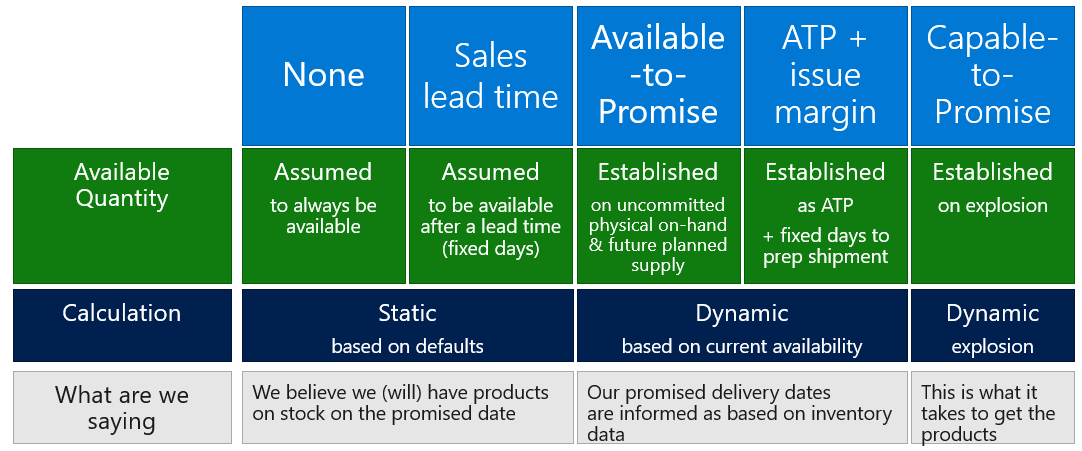Order promising concepts
Order promising helps you reliably promise delivery dates to your customers, and it gives you flexibility so that you can meet those dates.
Order promising calculates the earliest ship and receipt dates, and it's based on the delivery date control method and transport days.
Based on the delivery date control type on the sales order line, Supply Chain Management calculates the earliest delivery date and populates the following information:
Requested ship date - The earliest date that the company can dispatch the product's full line quantity from the warehouse that's specified on the line.
Requested receipt date - The earliest date that the customer can expect the product's full line quantity to be delivered to the customer's address.
The following image shows the five delivery date control types.
None
The following image shows the impact of order promising if the delivery date control is set to None. Order promising assumes that stock is always available and that the company can promise order shipment on the day that the order is taken.
Sales lead time
The following image shows the impact of order promising if the delivery date control is set to Sales lead time, which is the time between creation of the sales order and shipment of the items. The delivery date calculation is based on a default number of days and doesn't consider stock availability, known demand, or planned supply. You can define the lead time for a site. If you don't define site-specific lead time, then the system uses the default setting for the item.
Order promising assumes that stock is available beyond the lead time and that the company can promise order shipment regardless of the actual availability.
Available-to-promise
Available-to-promise (ATP) is the quantity of an item that's available and that the company can promise to a customer on a specific date. The ATP calculation includes uncommitted inventory, lead times, planned receipts, and issues.
ATP bases delivery promises on real-time data, and it also:
Eliminates or reduces reservations because it considers sales orders that are already entered (promised and unfulfilled).
Is customizable. You can fine-tune it with margin time.
Considers businesses' working calendars and carriers' and customers' calendars.
Requires high delivery performance from suppliers.
Doesn't require a planning run and uses already existing supply.
Is a good fit for the distribution industry and make-to-stock manufacturers.
Supports intercompany trade.
The following image shows the calculation of ATP. It checks uncommitted stock, supply, and committed demand.
ATP + issue margin
The earliest ship date is equal to the ATP date plus the issue margin for the item. The issue margin is the time that's required to prepare the items for shipment.
The following image shows the calculation of the ATP + issue margin. It checks uncommitted stock, supply, committed demand, and a fixed margin in days.
Capable-to-promise
Capable-to-promise (CTP) is when order promising is based on a dynamic plan (sales order line explosion). It checks availability and lead-time components in the BOM and process time in the routes of the finished product.
Delivery alternatives
Sales order takers can use the Delivery alternatives page to discover alternative order fulfillment options.
The Delivery alternatives page layout gives an overview of all alternative options. It also lets order takers look beyond the current company for fulfillment opportunities. On this page, order takers can view intercompany opportunities and opportunities from external vendors. By sorting the options by delivery date, sales order takers can view an intelligent list of delivery alternatives. Additionally, parameters help them manage the suggested deliveries better. Because transport time can affect delivery dates, sales order takers can explore the various transportation choices that carriers offer.
Consider the following delivery alternatives:
Program-calculated recommendations for the earliest delivery date based on:
Availability across sites
Availability for variants
Partial quantity
Alternative transportation options
Sourcing from external vendor or through intercompany, cross-docking, or as direct delivery
Insights into existing demand and supply to potentially reallocate and expedite
Support for all delivery date control methods





